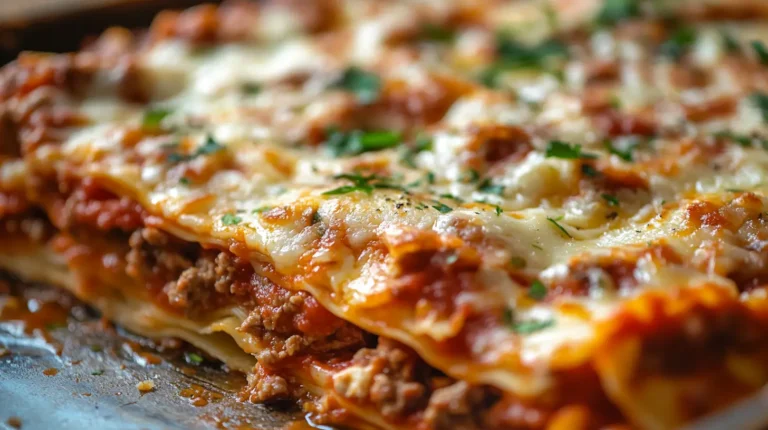If you’ve ever found yourself torn between ordering a cheesy slice of pizza or digging into a comforting plate of lasagna, you’re not alone. These two Italian-inspired comfort foods are loved worldwide, so why not bring them together? Enter lasagna pizza—a mouthwatering hybrid that combines the best of both worlds.
Imagine the gooey layers of ricotta, mozzarella, and marinara sauce you love from lasagna, baked atop a crispy pizza crust. Some versions even swap out traditional pizza dough for sheets of pasta! Whether you’re a home cook looking to try something new or just a foodie curious about this culinary mashup, this guide will take you through everything you need to know.
In this article, we’ll break down:
- What lasagna pizza actually is and how it stands out.
- How this creative dish evolved over time.
- The best ingredients, step-by-step recipes, and tasty variations.
- Pro tips for baking the perfect version at home.
Table of Contents
Get ready to discover a delicious fusion dish that’ll change your pizza nights forever!
What is Lasagna Pizza?
The Perfect Mashup of Two Comfort Foods
At its core, lasagna pizza is exactly what it sounds like—a genius blend of lasagna and pizza. But what does that actually mean? Well, different chefs and food lovers interpret it in their own ways. Some prefer layering classic lasagna noodles onto a pizza crust, while others bake all the traditional lasagna ingredients directly onto a thick, doughy base. Either way, the result is a cheesy, saucy, and utterly satisfying dish that gives you the best of both meals in one bite.
The beauty of lasagna pizza lies in its versatility. Whether you love deep-dish pizza, thin crust, or something in between, you can tweak this dish to suit your taste. Want to load it up with classic lasagna fillings like ricotta, Italian sausage, and marinara sauce? Go for it. Prefer a more pizza-forward approach with a touch of lasagna flavor? That works too!
How It Differs from Traditional Lasagna and Pizza
While lasagna pizza takes inspiration from both dishes, there are some key differences:
- The Base – Traditional lasagna uses layers of pasta, while lasagna pizza can be made with pizza dough, flatbread, or even pasta sheets.
- Sauce Distribution – Regular pizza usually has a smooth layer of tomato sauce, but lasagna pizza often uses dollops of sauce layered between cheeses, just like in classic lasagna.
- Cheese Layers – Unlike the usual sprinkle of mozzarella on pizza, lasagna pizza often features ricotta, mozzarella, and Parmesan, adding extra richness.
Why Food Lovers Are Excited About This Creation
The rise of lasagna pizza isn’t just a passing trend—it’s a reflection of how people love to experiment with food. Social media platforms are flooded with viral recipes and restaurant creations that push the boundaries of traditional cuisine. Foodies are always on the lookout for bold, indulgent flavors, and lasagna pizza checks all the right boxes.
Not to mention, it’s a fantastic dish for gatherings. Whether you’re feeding a crowd or just craving something extra indulgent, lasagna pizza brings a unique twist to any pizza night. Plus, with so many ways to customize it—spicy, vegetarian, extra cheesy—you’ll never get bored of this fun, flavorful hybrid!
The Origins and Evolution of Lasagna Pizza
Early Experiments with Combining Lasagna and Pizza
While lasagna pizza might seem like a modern food trend, the idea of blending these two Italian-inspired dishes has been around for a while. Home cooks and restaurant chefs have experimented with layering lasagna ingredients onto pizza crusts for years. Some took a more traditional approach, layering pasta sheets on dough, while others simply loaded classic lasagna toppings onto a deep-dish pizza base.
Food fusion has always played a major role in shaping the culinary world, and lasagna pizza is a perfect example of this creative experimentation. The mix of textures—crispy crust, gooey cheese, and rich tomato sauce—creates a flavor-packed bite that satisfies fans of both dishes.
Influences from Italian-American Cuisine
The roots of lasagna pizza can be traced back to the influence of Italian-American cuisine. In many ways, both lasagna and pizza evolved in the U.S. to become more indulgent, cheesier, and loaded with toppings compared to their traditional Italian counterparts. With deep-dish and stuffed pizzas gaining popularity in cities like Chicago, it was only a matter of time before someone thought to combine these iconic dishes into one.
Italian-American restaurants, especially pizzerias, played a significant role in pushing this trend. Many pizzerias began offering variations of lasagna pizza as a specialty item, featuring rich marinara sauces, ricotta cheese, and even layers of pasta baked onto a pizza crust.
Modern Takes on the Classic Combination
In recent years, lasagna pizza has gained traction on social media, with food bloggers and chefs sharing their unique twists. Some restaurants serve deep-dish versions with stacked layers of pasta, while others create thinner-crust variations that mimic the essence of lasagna with lighter toppings.
Fast-food chains and artisanal pizzerias alike have embraced the trend, each adding their own spin. Whether baked in a cast-iron skillet or served as a hand-tossed slice, lasagna pizza continues to evolve, proving that food mashups are here to stay.
Key Ingredients for the Ultimate Lasagna Pizza
The Base: Pizza Dough vs. Lasagna Noodles
One of the biggest decisions when making lasagna pizza is choosing the base. Do you go with classic pizza dough, or do you get creative with layers of lasagna noodles?
- Pizza dough base: A traditional pizza crust offers a crispy, chewy texture that holds up well under heavy toppings. It’s perfect for those who want a pizza-forward approach while still incorporating lasagna flavors.
- Lasagna noodle base: Some versions use sheets of lasagna pasta instead of dough, layering them directly onto a baking tray or deep-dish pan. This gives it a more authentic lasagna feel but with a slightly crispier finish.
Both options work well, so it really depends on whether you want more of a pizza or pasta experience!
Sauces: Traditional Tomato, Béchamel, or a Fusion of Both?
Sauce plays a huge role in defining the flavor of lasagna pizza. The most popular choices include:
- Classic marinara sauce – The go-to choice for most versions, offering a rich, tangy tomato flavor.
- Béchamel sauce – A creamy, buttery alternative that adds extra richness. Some chefs combine this with marinara for a unique taste.
- Pizza sauce – Similar to marinara but often thicker and more herb-forward, giving it a slightly different kick.
Many versions of lasagna pizza layer the sauce between cheese and meat to mimic the structure of traditional lasagna.
Cheese Choices: Mozzarella, Ricotta, Parmesan, and More
Cheese is what makes lasagna pizza extra indulgent. The best versions use a blend of:
- Mozzarella – Essential for that classic stretchy, melty texture.
- Ricotta – Adds creaminess and a mild sweetness, just like in traditional lasagna.
- Parmesan – Gives a sharp, nutty bite that enhances the overall flavor.
Some variations even include provolone or cheddar for an extra cheesy punch.
Toppings: Classic Lasagna Fillings vs. Pizza Toppings
The toppings you choose will determine whether your lasagna pizza leans more toward pizza or lasagna. Some popular options include:
- Ground beef or Italian sausage – A staple in both lasagna and many pizza styles.
- Pepperoni or pancetta – For those who want a more traditional pizza flavor.
- Bell peppers, onions, and mushrooms – Adds freshness and texture.
- Black olives and basil – For an extra Italian touch.
Whether you prefer a meaty, cheesy version or a lighter, veggie-packed one, the possibilities are endless. The secret? Layer your toppings strategically to create that perfect balance of flavor in every bite.
How to Make Lasagna Pizza at Home
Step-by-Step Guide to the Perfect Dough
If you’re making lasagna pizza from scratch, getting the dough right is key. A sturdy, yet crispy crust will hold up well under all the layers of sauce, cheese, and toppings. Here’s how to do it:
- Start with quality ingredients – Use high-protein flour, warm water, yeast, salt, and olive oil.
- Mix and knead – Combine ingredients, knead until smooth, and let it rise for at least an hour.
- Roll it out – Keep it slightly thicker than regular pizza dough to support the toppings.
If you’re using lasagna noodles as a base, boil them until slightly undercooked so they hold their shape during baking.
Layering Techniques for Maximum Flavor
The secret to a perfect lasagna pizza is in the layering. Here’s the best order for a balanced flavor:
- Sauce first – Spread marinara or pizza sauce evenly.
- Cheese mix – Dollop ricotta, then sprinkle mozzarella and Parmesan for that gooey melt.
- Protein layer – Add cooked ground beef, sausage, or pepperoni.
- Repeat – Add another layer of cheese and sauce to mimic lasagna’s structure.
Baking Tips for a Crispy Yet Cheesy Finish
- Preheat your oven to 450°F (232°C) to ensure a crispy crust.
- Use a pizza stone or baking steel for even heat distribution.
- Bake for 12-15 minutes or until the cheese is bubbling and golden brown.
Common Mistakes to Avoid
- Overloading with sauce – Too much will make the crust soggy.
- Skipping preheating – Always bake in a fully heated oven for the best results.
- Not draining ingredients – Excess moisture from ricotta or veggies can make the pizza watery.
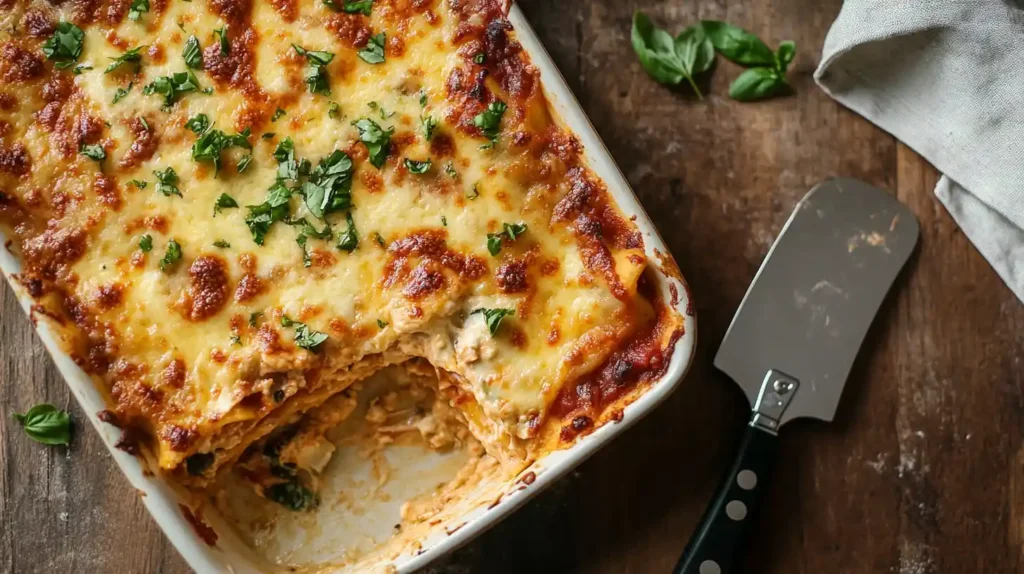
If you’re a fan of hearty baked dishes, you might also love trying this Million Dollar Spaghetti Recipe for another indulgent Italian-American classic
Variations and Creative Twists
Deep-Dish Lasagna Pizza
For those who love deep-dish pizza, this variation is a must-try. Instead of a regular crust, use a deep-dish pan and layer ingredients like you would in traditional lasagna. The thick layers of cheese and sauce make it extra indulgent!
Gluten-Free and Keto-Friendly Versions
If you’re avoiding gluten, swap out the regular crust for a gluten-free pizza dough or use thinly sliced zucchini or eggplant instead of lasagna noodles. For a keto-friendly version, use a cheese-based crust like fathead dough.
Vegan and Vegetarian Options
Love lasagna pizza but want a meat-free version? Here’s how:
- Use dairy-free cheese alternatives like cashew ricotta and vegan mozzarella.
- Replace meat with hearty options like mushrooms, lentils, or spinach.
- Opt for a robust homemade marinara sauce for depth of flavor.
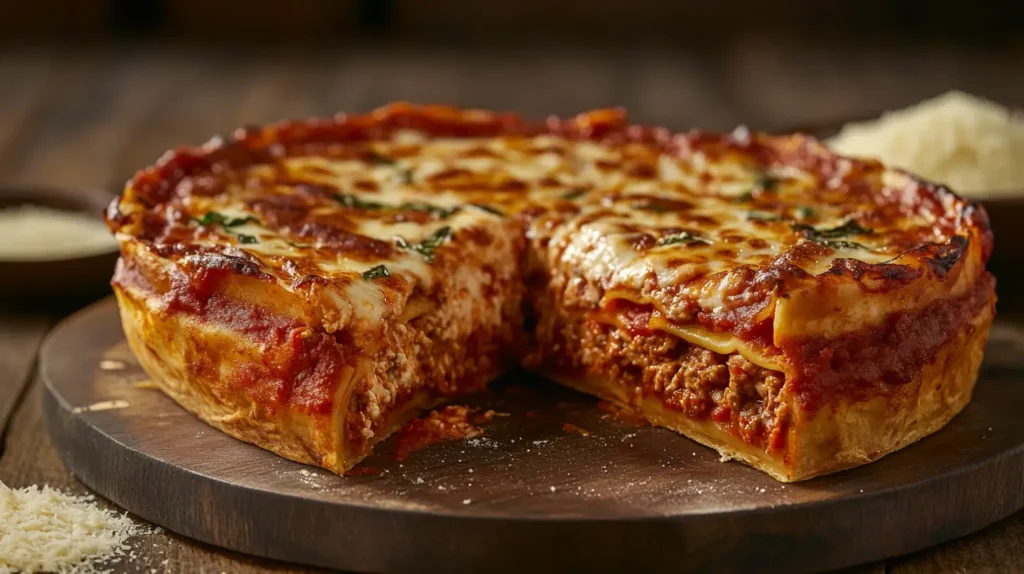
For those looking for a creative twist, why not explore this Taco Lasagna Recipe which blends Mexican flavors with traditional lasagna layers?
The Best Sauces and Pairings
Marinara vs. Alfredo: Which Works Best?
When it comes to lasagna pizza, the sauce choice makes all the difference. The two most popular options are classic marinara and creamy Alfredo, but which one is best?
Marinara Sauce: If you love a traditional lasagna flavor, marinara is the way to go. The rich tomato base, infused with garlic, basil, and oregano, adds a tangy depth that complements the cheese and crust perfectly.
Alfredo Sauce: For a richer, creamier twist, Alfredo sauce can take lasagna pizza to another level. Made with butter, cream, and Parmesan, it pairs well with grilled chicken, mushrooms, and spinach.
Want the best of both worlds? Some creative cooks combine marinara and Alfredo for a rosa sauce, balancing tangy and creamy flavors in every bite.
Best Sides to Serve with Lasagna Pizza
Pairing lasagna pizza with the right side dishes elevates the whole meal. Here are some great options:
- Garlic bread or cheesy breadsticks – Perfect for scooping up extra sauce.
- Caesar or garden salad – A fresh contrast to the rich, cheesy pizza.
- Roasted vegetables – Bell peppers, zucchini, and mushrooms bring a hearty, healthy touch.
Wine and Beverage Pairings
For drinks, a bold red wine like Chianti or a crisp white wine like Sauvignon Blanc pairs beautifully. If you prefer non-alcoholic options, sparkling lemonade or an Italian soda adds a refreshing balance.
Pairing the right sauce with your lasagna pizza is essential—just like choosing the perfect blend for this Alfredo Spaghetti Guide that showcases creamy pasta at its best.
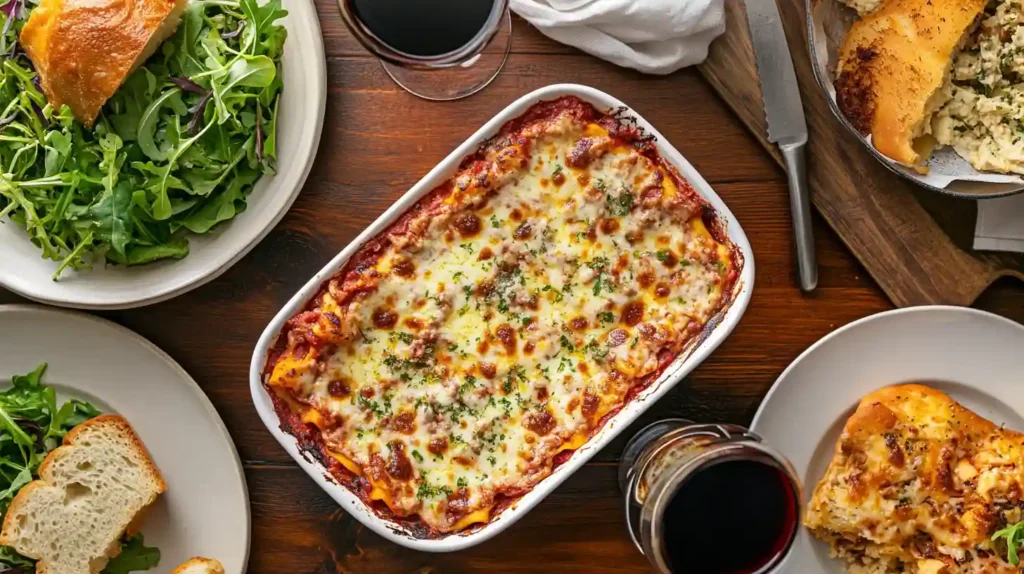
FAQs
Is lasagna pizza more like a pizza or pasta?
Lasagna pizza is a true hybrid—it depends on how it’s made. If you use a pizza dough base and top it with classic lasagna ingredients, it leans more toward pizza. However, if you layer lasagna noodles on a crust and stack the ingredients like traditional lasagna, it feels more like a pasta dish with a crispy twist. Either way, it delivers the best of both worlds!
Can I use pizza sauce in lasagna?
Yes! Pizza sauce is very similar to marinara sauce, making it a great substitute. The key difference is that pizza sauce is usually thicker and more concentrated since it’s designed to stay in place on a crust. If using it for lasagna, consider thinning it slightly with crushed tomatoes or water for a more even texture.
Does ricotta go on pizza before or after baking?
Ricotta cheese should be added before baking so it melds with the other ingredients. However, for a creamier, fresher taste, some people prefer dolloping extra ricotta on top after the pizza is baked.
Does ricotta melt when baked?
Unlike mozzarella, ricotta doesn’t fully melt. Instead, it softens and becomes creamy. This is why it’s perfect for layering in lasagna pizza—it adds a rich, smooth texture without losing its structure.
When making lasagna, do you put an egg in the ricotta cheese?
Yes, many traditional lasagna recipes mix an egg into ricotta cheese. The egg helps bind the cheese, preventing it from becoming too runny when baked. If you’re making lasagna pizza, adding an egg to the ricotta mixture can help it hold its shape better.
Conclusion
Lasagna pizza is more than just a fun mashup—it’s a dish that brings together the best of two comfort food favorites. Whether you love the crispy bite of pizza or the rich layers of lasagna, this fusion dish offers something for everyone.
With endless ways to customize—from deep-dish styles to gluten-free and vegan variations—lasagna pizza is a creative and delicious way to enjoy Italian-inspired flavors. Whether you’re making it at home or trying it at a local pizzeria, one thing is certain: this dish is a guaranteed crowd-pleaser.
So, why choose between pizza and lasagna when you can have both? Give lasagna pizza a try, experiment with flavors, and enjoy a dish that truly brings the best of both worlds to your table!
If you’re interested in more unique pizza creations, check out this Pickle Pie Pizza Recipe for another unexpected but delicious fusion.
Print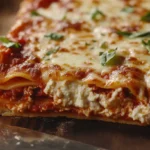
Lasagna Pizza: The Ultimate Fusion of Two Classics
- Total Time: 30 minutes
- Yield: 1 medium pizza 1x
Description
Lasagna pizza is the perfect mashup of two Italian favorites—cheesy, saucy lasagna and crispy, flavorful pizza. This indulgent dish combines layers of ricotta, marinara, mozzarella, and Italian sausage atop a golden-brown pizza crust, delivering a hearty bite of comfort food in every slice. Whether you’re hosting a pizza night or simply craving something unique, this easy-to-make recipe will satisfy both pizza and pasta lovers alike.
Ingredients
For the Pizza Dough (if making from scratch):
- 2 ½ cups all-purpose flour
- 1 packet (2 ¼ tsp) active dry yeast
- ¾ cup warm water (110°F or 45°C)
- 1 tbsp olive oil
- 1 tsp salt
- 1 tsp sugar
For the Sauce & Cheese Layer:
- 1 cup marinara sauce
- ¾ cup ricotta cheese
- 1 ½ cups shredded mozzarella cheese
- ¼ cup grated Parmesan cheese
- 1 tsp dried oregano
- ½ tsp garlic powder
- ½ tsp crushed red pepper flakes (optional)
For the Meat & Toppings:
- ½ lb ground Italian sausage (or ground beef)
- ¼ cup diced onions
- ¼ cup sliced mushrooms (optional)
- ¼ cup black olives (optional)
- 6–8 pepperoni slices (optional)
- Fresh basil for garnish
Instructions
Step 1: Prepare the Dough (Skip if Using Store-Bought)
- In a small bowl, mix warm water, yeast, and sugar. Let it sit for 5 minutes until foamy.
- In a large mixing bowl, combine flour and salt. Add the yeast mixture and olive oil.
- Knead the dough for 5-7 minutes until smooth. Cover and let it rise in a warm place for 1 hour or until doubled in size.
- Preheat oven to 450°F (232°C).
Step 2: Cook the Meat
- In a skillet over medium heat, cook Italian sausage with diced onions until browned. Drain excess grease and set aside.
Step 3: Assemble the Pizza
- Roll out the pizza dough on a floured surface to your desired thickness. Transfer to a pizza stone or baking sheet.
- Spread marinara sauce evenly over the dough.
- Dollop spoonfuls of ricotta cheese over the sauce.
- Sprinkle cooked sausage and any additional toppings evenly over the pizza.
- Add shredded mozzarella and Parmesan cheese on top.
- Season with oregano, garlic powder, and crushed red pepper flakes.
Step 4: Bake the Pizza
- Bake in the preheated oven for 12-15 minutes or until the cheese is bubbling and the crust is golden brown.
- Remove from the oven and let it cool for 5 minutes.
- Garnish with fresh basil, slice, and serve hot.
Notes
- Variation: For a low-carb version, use a cauliflower crust or layer lasagna noodles instead of dough.
- Make it Vegetarian: Omit the meat and add more veggies like bell peppers, spinach, and zucchini.
- Spicy Twist: Add spicy Italian sausage or drizzle hot honey on top for a bold flavor contrast.
- Serving Suggestion: Pair with garlic breadsticks and a fresh Caesar salad for a complete meal.
- Prep Time: 15 minutes
- Cook Time: 15 minutes
- Category: Lunch
- Cuisine: Italian-American
Nutrition
- Serving Size: 1 pizza (serves 4)
- Calories: 450
- Fat: 18g
- Carbohydrates: 45g
- Protein: 20g
Keywords: Lasagna Pizza

